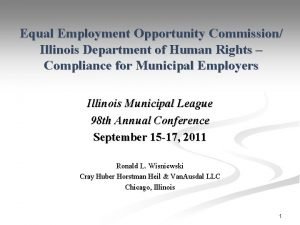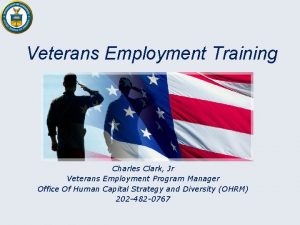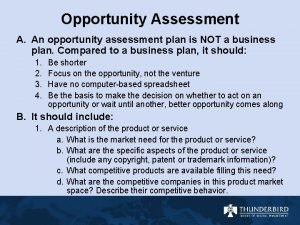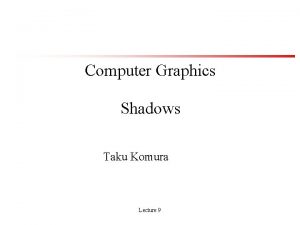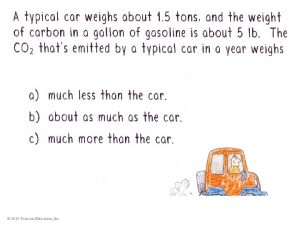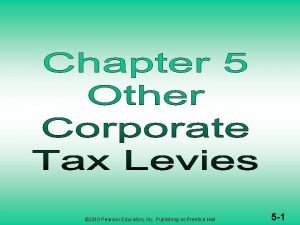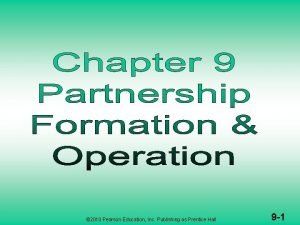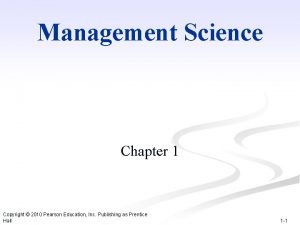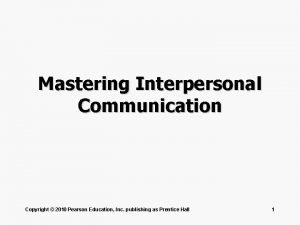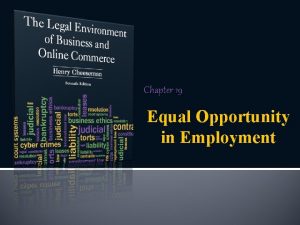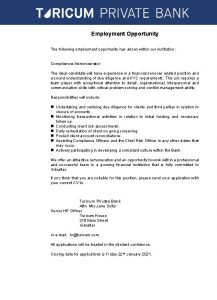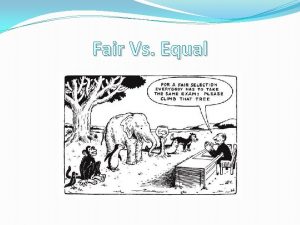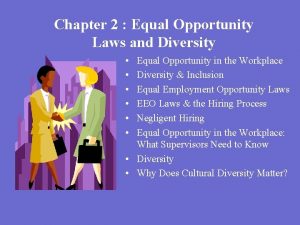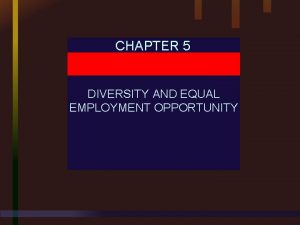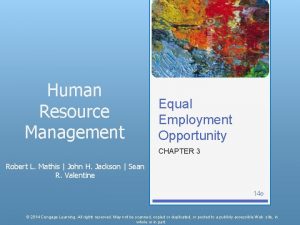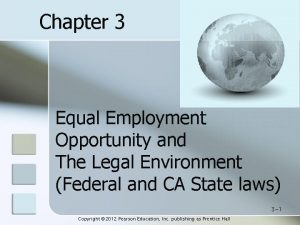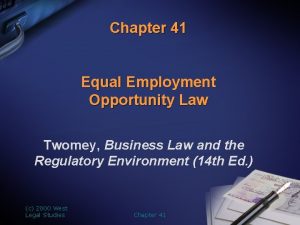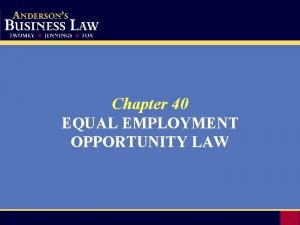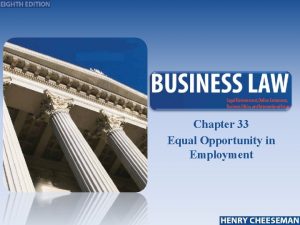CHAPTER 33 EQUAL OPPORTUNITY IN EMPLOYMENT 2010 Pearson
































- Slides: 32

CHAPTER 33 EQUAL OPPORTUNITY IN EMPLOYMENT © 2010 Pearson Education, Inc. , publishing as Prentice-Hall 1

Equal Opportunity in Employment Right of all employees and job applicants: – To be treated without discrimination, and – To be able to sue employers if discriminated against. © 2010 Pearson Education, Inc. , publishing as Prentice-Hall 2

Title VII of the Civil Rights Act of 1964 • Outlaws job discrimination based on five protected classes: – Race – Color – National origin – Sex – Religion © 2010 Pearson Education, Inc. , publishing as Prentice-Hall 3

Scope of Coverage of Title VII • Title VII applies to: – Employers with 15 or more employees – All employment agencies – Labor unions with 15 or more members – State and local governments and their agencies – Most federal government employment © 2010 Pearson Education, Inc. , publishing as Prentice-Hall 4

Scope of Coverage of Title VII (continued) • Title VII prohibits discrimination in: – Hiring and firing – Work rules – Promotion and demotion – Payment of compensation and benefits – Availability of job training opportunities – Any other term, condition, or privilege of employment © 2010 Pearson Education, Inc. , publishing as Prentice-Hall 5

Forms of Discrimination Disparate Treatment • Employer discriminates against specific individual because race, color, national origin, sex, or religion. © 2010 Pearson Education, Inc. , publishing as Prentice-Hall Disparate Impact • Employer discriminates against an entire protected class. • Often proven by statistical data about employer’s employment practices. 6

Equal Employment Opportunity Commission (EEOC) • Federal administrative agency responsible for enforcing most federal antidiscrimination laws. • Empowered to: – Conduct investigations – Interpret statutes – Encourage conciliation between employees and employers – Bring suit to enforce law © 2010 Pearson Education, Inc. , publishing as Prentice-Hall 7

Procedure for Bringing Title VII Action • Private complainant must file complaint with EEOC within 180 or 300 days of discrimination (depending on state). • EEOC is given the opportunity to sue the employer on the complainant’s behalf. • If EEOC chooses not to bring suit, it will issue a right to sue letter. • Complainant now may sue employer. © 2010 Pearson Education, Inc. , publishing as Prentice-Hall 8

Remedies for Violations of Title VII • Successful plaintiff can recover: – Back pay and reasonable attorneys’ fees. – Possible equitable relief, including reinstatement and seniority. – Punitive damages for intentional discrimination. © 2010 Pearson Education, Inc. , publishing as Prentice-Hall 9

Race, Color, and National Origin Discrimination – Race: refers to broad categories such as Black, Asian, Caucasian, and Native American. – Color: refers to the color of a person’s skin. – National Origin: refers to the country of a person’s ancestors or cultural characteristics. • E. g. , Hispanics, persons of Middle Eastern descent. © 2010 Pearson Education, Inc. , publishing as Prentice-Hall 10

Sex Discrimination • Discrimination against a person solely because of his or her gender. – Applies equally to men and women. – Overwhelming majority of Title VII sex discrimination cases are brought by women. © 2010 Pearson Education, Inc. , publishing as Prentice-Hall 11

Sexual Harassment – Lewd remarks, touching, intimidation, posting pinups, and other verbal or physical conduct of a sexual nature. • E. g. , supervisor offering positive review in exchange for sex. – Hostile work environment. © 2010 Pearson Education, Inc. , publishing as Prentice-Hall 12

Sexual Harassment (continued) • Employer may defend by showing that • employer exercised reasonable care to prevent and correct harassing behavior, and • That plaintiff failed to take advantage of employer’s programs or to otherwise avoid harm. © 2010 Pearson Education, Inc. , publishing as Prentice-Hall 13

Other Actionable Sex Discrimination • Discrimination because of “pregnancy, childbirth, or related medical conditions. ” • Same-sex discrimination. © 2010 Pearson Education, Inc. , publishing as Prentice-Hall 14

Religious Discrimination • Discrimination based on a person’s religion or religious practices. – Includes nontraditional religions. • Employer has duty to reasonably accommodate an employee’s religious practices, observances, or beliefs if it does not cause an undue hardship for employer. – E. g. , try to arrange schedule to give Sabbath as day off. © 2010 Pearson Education, Inc. , publishing as Prentice-Hall 15

Defenses to Title VII Action Merit Seniority Bona Fide Occupational Qualification (BFOQ) © 2010 Pearson Education, Inc. , publishing as Prentice-Hall 16

Bona Fide Occupational Qualification (BFOQ) • Employment discrimination based on a protected class (other than race or color) is lawful if it is: – Job related, and a – Business necessity. • E. g. , only a woman can work as a wet nurse. • Exception is narrowly interpreted by the courts. © 2010 Pearson Education, Inc. , publishing as Prentice-Hall 17

Civil Rights Act of 1866 • All persons “have the same right to make and enforce contracts as is enjoyed by white persons. ” • Prohibits racial and national origin employment discrimination. • Procedural requirements of Title VII do not apply. • No cap on damages. © 2010 Pearson Education, Inc. , publishing as Prentice-Hall 18

Equal Pay Act • Protects both sexes from pay discrimination based on sex. • The act prohibits disparity in pay for jobs that require: – Equal skill – Equal effort – Equal responsibility – Similar working conditions © 2010 Pearson Education, Inc. , publishing as Prentice-Hall 19

Criteria That Justify a Differential in Wages • Four criteria that justify a differential in wages: – Seniority – Merit – Quantity or quality of product – Any factor other than sex • Employer bears the burden of proving these defenses. © 2010 Pearson Education, Inc. , publishing as Prentice-Hall 20

Age Discrimination in Employment Act • ADEA applies to employees who are 40 years of age and older. • Administered by EEOC. • Successful plaintiff may recover back wages, attorney fees, and equitable relief. © 2010 Pearson Education, Inc. , publishing as Prentice-Hall 21

Age Discrimination in Employment Act (continued) • Prohibits age discrimination in all employment decisions, including: – Hiring – Promotions – Payment of compensation – Employee benefits – Other terms and conditions of employment • Prohibits mandatory retirement ages. © 2010 Pearson Education, Inc. , publishing as Prentice-Hall 22

Americans with Disabilities Act • Employers and providers of public transportation, telecommunications, and public accommodations must accommodate individuals with disabilities. • Employers may not discriminate against qualified individuals with disabilities. © 2010 Pearson Education, Inc. , publishing as Prentice-Hall 23

Title I of the ADA requires an employer to make reasonable accommodations to individuals with disabilities that do not cause undue hardship to the employer. © 2010 Pearson Education, Inc. , publishing as Prentice-Hall 24

Reasonable Accommodation Under ADA • Reasonable accommodations may include: – Making facilities readily accessible – Providing part-time or modified work schedules – Acquiring equipment or devices – Modifying examination and training materials – Providing qualified readers or interpreters © 2010 Pearson Education, Inc. , publishing as Prentice-Hall 25

Qualified Individual with a Disability • A person who, with or without reasonable accommodation, can perform the essential functions of the job that person desires or holds. © 2010 Pearson Education, Inc. , publishing as Prentice-Hall 26

Qualified Individual with a Disability (continued) A disabled person is someone who: • • • Has a physical or mental impairment that substantially limits one or more of his or her major life activities, Has a record of such impairment, or Is regarded as having such impairment. © 2010 Pearson Education, Inc. , publishing as Prentice-Hall 27

Forbidden Conduct • Employers are forbidden from asking a job applicant about the existence, nature, and severity of a disability. • Pre-employment medical examinations are forbidden before a job offer. © 2010 Pearson Education, Inc. , publishing as Prentice-Hall 28

ADA Procedure and Remedies • Aggrieved person must first file charge with EEOC. – EEOC may choose to take action, or – Issue right to sue letter. • Successful plaintiff can recover: – Back pay and reasonable attorneys’ fees. – Possible equitable relief, including reinstatement and seniority. – Punitive damages for intentional discrimination. © 2010 Pearson Education, Inc. , publishing as Prentice-Hall 29

Affirmative Action • Certain job preferences given to minority, female, or other applicants when employer makes an employment decision. • May be voluntarily adopted, undertaken to settle discrimination action, or ordered by courts. • Legal if narrowly tailored to achieve compelling interest. © 2010 Pearson Education, Inc. , publishing as Prentice-Hall 30

Reverse Discrimination • Title VII protects members of majority class. • Affirmative action plans may not have preestablished quotas. • Majority class members may sue for damages. © 2010 Pearson Education, Inc. , publishing as Prentice-Hall 31

Retaliation • Employers may not retaliate against employee for filing charge of discrimination or participating in proceeding brought under Title VII, ADEA, or Section 1981. • E. g. , dismissing, demoting, harassing. © 2010 Pearson Education, Inc. , publishing as Prentice-Hall 32
 Equal opportunity illinois
Equal opportunity illinois Equal opportunity and the law chapter 2
Equal opportunity and the law chapter 2 Veterans employment opportunity act
Veterans employment opportunity act Opportunity recognition and opportunity assessment plan
Opportunity recognition and opportunity assessment plan Equal opportunity fund
Equal opportunity fund Equal height equal light
Equal height equal light Equal height equal light
Equal height equal light Equal grouping
Equal grouping Opposite angle theorem
Opposite angle theorem Meridionalnet
Meridionalnet 2010 pearson education inc
2010 pearson education inc 2010 pearson education inc
2010 pearson education inc 2010 pearson education inc answers
2010 pearson education inc answers 2010 pearson education inc answers
2010 pearson education inc answers 2010 pearson education inc answers
2010 pearson education inc answers 2010 pearson education inc answers
2010 pearson education inc answers 2010 pearson education inc
2010 pearson education inc 2010 pearson education inc
2010 pearson education inc Copyright 2010 pearson education inc
Copyright 2010 pearson education inc 2010 pearson education inc
2010 pearson education inc Copyright 2010 pearson education inc
Copyright 2010 pearson education inc 2010 pearson education inc answers
2010 pearson education inc answers 2010 pearson education inc answers
2010 pearson education inc answers 2010 pearson education inc
2010 pearson education inc Pearson education 2010
Pearson education 2010 2010 pearson education inc
2010 pearson education inc Pearson 2010
Pearson 2010 2010 pearson education inc answers
2010 pearson education inc answers 2010 pearson education inc
2010 pearson education inc 2010 pearson education inc
2010 pearson education inc 2010 pearson education inc answers
2010 pearson education inc answers 2010 pearson education inc
2010 pearson education inc 2010 pearson education inc
2010 pearson education inc
